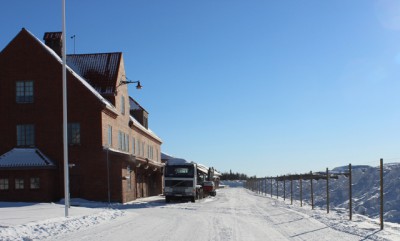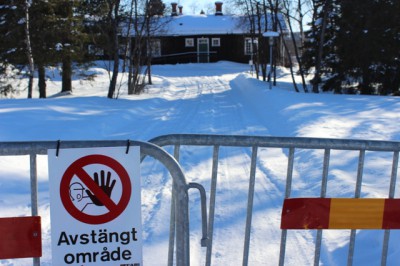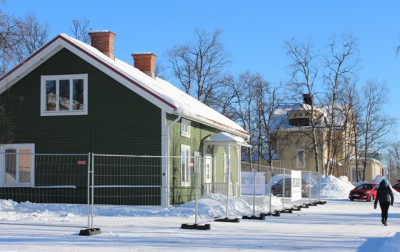It’s school holidays in Kiruna – ‘Sportlov’, the winter sporting week – and the weather is winter-glorious. Most of Kiruna is out in the fjäll, or, if not, out in the landscape of Kiruna, sledding down the snow-covered old pits, skiing across the lake, making food over open fires in windshelters by the roadside. We were tempted out yesterday, but recent colds made us unfit for lengthy exposure and we couldn’t find an available windshelter that wasn’t full of smoke. That left us driving around town, looking for a sheltered place to sit.
We were looking for a sheltering building where we might be able to avoid people cooking sausages and enjoying themselves (which is all well and good in theory but sometimes you just want some peace and quiet). We wanted an unpopular, abandoned sort of place, but in town. Then we thought of Kiruna station. The old building, already out of use and due to be knocked down sometime this year, according to the mining company, LKAB. The godfather had spoken and the building was going to be taken out. It was a good thought to make use of it while we still could.
When we got to the station there was a lorry, men in fluorescent jackets, and – running along the old rail track – a new fence, separating the station from the mine, with a pile of snow stacked up behind it. Beside it, the path I liked to run along had become a dead end.
The men in fluorescent jackets eyed us uneasily. Clearly this wasn’t going to be a very relaxing place to sit in the sunshine. It was the beginning of the end for the railway station, and the work had begun, we noted, when Kiruna was on holiday.

The story continued all over town. Diggers, mysteriously digging by the roadside; heavy wire fencing stacked up next to buildings; old houses enclosed behind fencing and locked gates; signs warning us to ‘Keep Out’. It was the day that LKAB began removing some of Kiruna, and the first time we had experienced what it would be like to live with fenced-off, no-go areas in the middle of town. It felt a bit creepy.


In the town’s ‘mine park’, already defined by LKAB as a ‘moving oasis’ – where a park would replace the buildings moved elsewhere or knocked down – the giant photos of some of Kiruna’s first inhabitants stared blankly out at the newly fenced-off areas, their stares seeming more knowing than before. Nothing stays the same. Despite all the razzmatazz about the current plan to move the town, this has all happened before. A whole community disappeared just behind here – streets, houses, roads, shops, businesses, childhood memories. This is how it is Kiruna; you move on.
As an exercise in change management it can’t be faulted. You tell people what you are going to do, you give them some time to plan their response, and then, one day, you do it. You don’t slowly let things deteriorate. You don’t pull a tooth, one by one, increasing the agony with cruel anticipation. You plan the destruction, and then you destroy. And, it isn’t a bad idea to start when people’s attention is elsewhere, and then there it will be, a done deed, no going back.
When things in your past stand in the way of where you want to go, you have to cut yourself off from them. Just don’t go there. I’m trying to see it that way – that there’s no point lingering where you no longer have a life. It’s cruel, the destruction of the town, but there are things to be learned from it.

